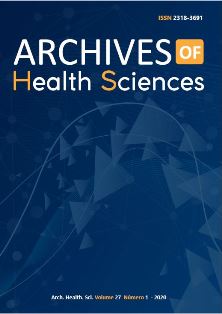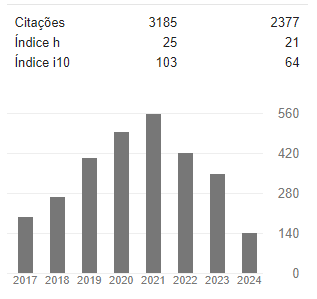Análise de marcadores não-invasivos de fibrose em portadores de doença hepática gordurosa não alcoólica
DOI:
https://doi.org/10.17696/2318-3691.27.1.2020.1667Palavras-chave:
Hepatopatia Gordurosa não Alcoólica; Cirrose Hepática; Fígado GordurosoResumo
Introdução: o diagnóstico da doença hepática gordurosa não alcoólica (DHGNA), é realizado pela biópsia hepática que direciona o seu tratamento. Como desvantagens da biópsia,têm-se o custo do procedimento, a possibilidade de erro amostral e a morbidade. Visando minimizar e/ou direcionar a indicação da biópsia hepática, marcadores não-invasivos têm sido propostos para avaliar fibrose em portadores de DHGNA. Objetivos: Analisar a eficácia dos escores não–invasivos de fibrose APRI e FIB-4 na avaliação de pacientes com DHGNA e verificar o seu benefício na prática clínica. Métodos: Estudo transversal incluindo pacientes com DHGNA submetidos à biópsia de fígado. Definiu-se como fibrose significante, o estádio maior ou igual a dois na biópsia, usada como padrão-ouro. Curvas ROC foram utilizadas para avaliar o desempenho diagnóstico dos escores em predizer a presença ou ausência de fibrose significativa. Resultados: Foram incluídos 33 pacientes adultos, com média de idade 46,4 ± 11,05 anos. Foram considerados como pontos de corte para fibrose não significativa, os valores iguais ou menores do que 0,33 e 1,3 para o APRI e o FIB-4, respectivamente. As AUROC foram 0,68 para o APRI e 0,63 para o FIB-4. A presença de cirrose foi considerada nos pontos de corte 1 e 2,67 para o APRI e FIB-4, respectivamente. Os VPP e VPN para excluir fibrose significativa foram: APRI 90% e 46,15% e para o FIB-4 de 85,18% e 66,66%, respectivamente. O procedimento poderia ter sido corretamente evitado em 54,5 % com o APRI e 66,7 % com o FIB-4, se restringíssemos a indicação de biópsia hepática aos indivíduos com valores intermediários de cada escore. Conclusão: Embora os modelos APRI e FIB-4 tenham apresentado sensibilidade e especificidade sub-ótimas para diferenciar fibrose significativa, para a maioria dos pacientes a biópsia poderia ter sido evitada com a aplicação dos escores, o que corrobora sua utilização na prática clínica.
Referências
Angulo P, Kleiner DE, Dam-Larsen S, Adams LA, Bjornsson ES, Charatcharoenwitthaya P, et al. Liver fibrosis, but no other histologic features, is associated with long-term outcomes of patients with nonalcoholic fatty liver disease. Gastroenterol. 2015;149(2):389-97. https://doi.org/10.1053/j.gastro.2015.04.043
Khan RS, Newsome PN. Non-alcoholic fatty liver disease and liver transplantation. Metabolism. 2016;65(8):1208-23. doi: 10.1016/j.metabol.2016.02.013
Kaswala DH, Lai M, Afdhal NH. Fibrosis Assessment in Nonalcoholic Fatty Liver Disease (NAFLD) in 2016. Dig Dis Sci. 2016;61(5):1356-64. doi: 10.1007/s10620-016-4079-4
Rinella ME, Sanyal AJ. Management of NAFLD: a stagebased approach. Nat Rev Gastroenterol Hepatol. 2016;13(4):196- 205. doi: 10.1038/nrgastro.2016.3
Hannah Jr WN, Harrison SA. Noninvasive imaging methods to determine severity of nonalcoholic fatty liver disease and nonalcoholic steatohepatitis. Hepatol. 2016;64(6):2234-43. doi: 10.1002/hep.28699
Dongiovanni P, Romeo S, Valenti L. Genetic factors in the pathogenesis of nonalcoholic fatty liver and steatohepatitis. Biomed Res. Int. 2015;2015:460190. doi: 10.1155/2015/460190
Ekstedt M, Hagström H, Nasr P, Fredrikson M, Stål P, Kechagias S, et al. Fibrosis stage is the strongest predictor for disease-specific mortality in NAFLD after up to 33 years of follow-up. Hepatol. 2015;61(5):1547-54. doi: 10.1002/hep.27368
Chang Y, Jung HS, Cho J, Zhang Y, Yun KE, Lazo M, et al. Metabolically healthy obesity and the development of nonalcoholic fatty liver disease. Am J Gastroenterol. 2016;111(8):1133-40. doi: 10.1038/ajg.2016.178
Fattahi MR, Niknam R, Safarpour A, Sepehrimanesh M, Lotfi M. The prevalence of metabolic syndrome in non-alcoholic fatty liver disease; a population-based study. Middle East J Dig Dis. 2016;8(2):131-7. doi: 10.15171/mejdd.2016.18
Machado MV, Cortez-Pinto H. Non-alcoholic fatty liver disease: what the clinician needs to know. World J. Gastroenterol. 2014 ;20(36):12956-80. doi: 10.3748/wjg.v20.i36.12956
Ahmed A, Wong RJ, Harrison SA. Nonalcoholic fatty liver disease review: diagnosis, treatment, and outcomes. Clin Gastroenterol Hepatol. 2015;13(12):2062-70. doi: 10.1016/j.cgh.2015.07.029
Bonder A, Tapper EB, Afdhal NH. Contemporary assessment of hepatic fibrosis. Clin Liver Dis. 2015;19(1):123-34. doi: 10.1016/j.cld.2014.09.007
Sun W, Cui H, Li N, Wei Y, Lai S, Yang Y, et al. Comparison of FiB-4 index, NAFLD fibrosis score and BARD score for prediction of advanced fibrosis in adult patients with non-alcoholic fatty liver disease: a meta-analysis study. Hepatol Res. 2016;46(9):862-70. doi: 10.1111/hepr.12647
Ucar F, Sezer S, Ginis Z, Ozturk G, Albayrak A, Basar O, et al. APRI, the FiB-4 score, and Forn’s index have noninvasive diagnostic value for liver fibrosis in patients with chronic hepatitis B. Eur J Gastroenterol Hepatol. 2013;25(9):1076-81. doi: 10.1097/MEG.0b013e32835fd699
Peleg N, Issachar A, Sneh-Arbib O, Shlomai A. AST to Platelet Ratio Index and fibrosis 4 calculator scores for non-invasive assessment of hepatic fibrosis in patients with non-alcoholic fatty liver disease. Dig Liver Dis. 2017;49(10):1133-8. doi: 10.1016/j.dld.2017.05.002
Calès P, Lainé F, Boursier J, Deugnier Y, Moal V, Oberti F, et al. Comparison of blood tests for liver fibrosis specific or not to NAFLD. J Hepatol. 2009;50(1):165-73. doi: 10.1016/j.jhep.2008.07.035
Shah AG, Lydecker A, Murray K, Tetri BN, Contos MJ, Sanyal AJ. Comparison of noninvasive markers of fibrosis in patients with nonalcoholic fatty liver disease. Clin Gastroenterol Hepatol. 2009;7(10):1104-12. doi: 10.1016/j.cgh.2009.05.033
National Cholesterol Education Program (NCEP) Expert Panel on Detection, Evaluation, and Treatment of High Blood Cholesterol in Adults (Adult Treatment Panel III). Third Report of the National Cholesterol Education Program (NCEP) Expert Panel on Detection, Evaluation, and Treatment of High Blood Cholesterol in Adults (Adult Treatment Panel III) final report. Circulation. 2002;106(25):3143-421. https://doi.org/10.1161/circ.106.25.3143
Tapper EB, Krajewski K, Lai M, Challies T, Kane R, Afdhal N, et al. Simple non-invasive biomarkers of advanced fibrosis in the evaluation of non-alcoholic fatty liver disease. Gastroenterol Rep (Oxf). 2014;2(4):276-80. doi: 10.1093/gastro/gou034
Loaeza-del-Castillo A, Paz-Pineda F, Oviedo-Cárdenas E, Sánchez-Avila F, Vargas-Vorácková F. AST to platelet ratio index (APRI) for the noninvasive evaluation of liver fibrosis. Ann Hepatol. 2008;7(4):350-7. https://doi.org/10.1016/S1665-2681(19)31836-8
Fujii H, Enomoto M, Fukushima W, Ohfuji S, Mori M, Kobayashi S, et al. Noninvasive laboratory tests proposed for predicting cirrhosis in patients with chronic hepatitis C are also useful in patients with non-alcoholic steatohepatitis. J Gastroenterol. 2009;44(6):608-14. doi: 10.1007/s00535-009-0046-6
McPherson S, Stewart SF, Henderson E, Burt AD, Day CP. Simple non-invasive fibrosis scoring systems can reliably exclude advanced fibrosis in patients with non-alcoholic fatty liver disease. Gut. 2010;59(9):1265-9. doi: 10.1136/gut.2010.216077
Mussini C, Lorenzini P, Puoti M, Lichtner M, Lapadula G, Di Giambenedetto S, et al. Prognostic Value of the Fibrosis-4 Index in Human Immunodeficiency Virus Type-1 Infected Patients Initiating Antiretroviral Therapy with or without Hepatitis C Virus. PLoS One. 2015;10(12):e 0140877. https://doi.org/10.1371/journal.pone.0140877
Chalasani N, Younossi Z, Lavine JE, Charlton M, Cusi K, Rinella M, et al. The diagnosis and management of nonalcoholic fatty liver disease: practice guidance from the American association for the study of liver diseases. Hepatol. 2018; 67(1):328 -57. doi: 10.1002/hep.29367
Liao R, Fu YP, Wang T, Deng ZG, Li DW, Fan J, et al. Metavir and FiB-4 scores are associated with patient prognosis after curative hepatectomy in hepatitis B virus-related hepatocellular carcinoma: a retrospective cohort study at two centers in China. Oncotarget. 2017;8(1):1774-87. doi: 10.18632/oncotarget.12152
Lin ZH, Xin YN, Dong QJ, Wang Q, Jiang XJ, Zhan SH, et al. Performance of the aspartate aminotransferase-to-platelet ratio index for the staging of hepatitis C-related fibrosis: an updated meta-analysis. Hepatol. 2011;53(3):726-36. doi: 10.1002/hep.24105
Nalbantoglu ILK, Brunt EM. Role of liver biopsy in nonalcoholic fatty liver disease. World J Gastroenterol. 2014 ;20:9026-37. doi: 10.3748/wjg.v20.i27.9026
Downloads
Publicado
Edição
Seção
Licença

Este trabalho está licenciado sob uma licença Creative Commons Attribution-NonCommercial-NoDerivatives 4.0 International License.











